
Change is coming to Fresno State’s wireless Internet after a system overload led to the university’s decision to implement a new system.
After receiving calls and complaints of increased log in wait times, some students reported wait times of up to one minute. Jim Michael, executive director of technology services at Fresno State, said the current network began experiencing delays on Aug. 28.
Michael said the network, which registers sometimes more than 15,000 users daily, usually works well inside most buildings. He said the portal that gives users permission to access the network was overloaded by the large number of devices on campus.
“Even when the phones, tablets””when the person isn’t actively trying to use the network, just the fact that it’s [the device] saying, ‘I’m here, I’m here, I’m here,’ is keeping that server really busy,” Michael said. “And the more of them saying, ‘I’m here, I’m here,’ the busier it gets.”
Michael said engineers spent half the day on Aug. 28 putting a quick fix in place to decrease the wait time. With so many students reporting technology issues, the team ultimately decided to start implementing larger changes that were initially intended for the spring semester.
Fresno State’s network engineers decided, Michael said, to replace the existing network with one that, instead of requiring students to log in every time they move from building to building, would only require them to log in once per day.
“I met with vice president [Cynthia] Matson yesterday to speak with her about what we intend to do,” Michael said. “She immediately supported making that change because it’s going to provide the improvement the students need to see.”
He said this network will cost less than $20,000 a year, and will be part of an ongoing effort to improve the wireless connections at Fresno State as the demand for technology inside and outside of the classroom increases.
“Dr. [Joseph] Castro’s vision of having tablet initiatives for students, for instance, would change where we need wireless,” Michael said. “If more folks show up wanting to use tablets in a classroom, we need to make certain there’s enough wireless coverage in the classrooms where they’re going to be using those devices.”
Michael said other factors can affect the speed and reliability of the wireless network in certain areas. He said the number of people using any given connection can slow the connection down.
“Our technical staff works to identify areas where additional access points are needed to provide more capacity,” Michael said. “Last year during some peak periods, we used special equipment to measure the use of the wireless network on campus and added capacity to high-demand locations like the area near Starbucks in the library.”
Michael said his team will continue to monitor the connections on campus and add more capacity to those access points, if needed, but he said sometimes the problem is not the connection or even number of people using it.
If students are having trouble connecting to the wireless network outside of a building, Michael said the fact that they’re outside could be the issue. The current network is only designed for interior spaces.
“Sometimes there’ll be a signal outside,” Michael said. “It’s like when you see people leaning up against the wall by Best Buy or something with their laptops, and they’re using the wireless.
“It’s not designed to be outside the building; it just happens to be outside the building.”
Fresno State junior Tim Jeung, a civil engineering major, said he can’t get his laptop to stay connected to the WiFi inside the University Student Union.
“It’s been kicking off my computer very often actually,” Jeung said Wednesday. “I couldn’t get on yesterday to attempt to do my homework. I tried for about 20 minutes.”
Jeung said he never had problems with the connection before this year. When asked if it could be because he was trying to log in at a busy time, Jeung said he uses the connection at less-busy times.
“Lunch time, yes,” Jeung said. “But then also again at about 4 p.m., and still nothing.”
Jeung said he hasn’t tried the connections in any other buildings, but found a way to work around his situation.
“The USU is usually where I come to do my work,” Jeung said. “So, yes, I’m using a friend’s [laptop] for right now.”
As it is, Michael said he hopes plans for a new network will be the first steps in an ongoing plan to improve technology services for students.
“If we don’t keep paying attention to this, it’s going to get ahead of us because it’s an area where there’s going to be constant change,” Michael said. “So we have to just keep paying attention and making the necessary changes as we go.”





Carlos Cazador • Sep 11, 2013 at 11:43 am
Take a look at Stanford U Palo Alto for some ideas